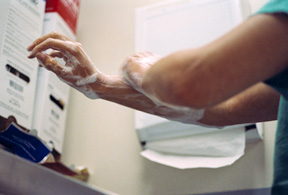If poor hygiene fosters disease, why are hospitals so non-compliant with hand washing?
It may seem a strange principle to enunciate as the very first requirement in a hospital that it should do the sick no harm.— Florence Nightingale
 Florence Nightingale’s words still ring true today. If she were able to view our world, what would she say about the current state of hand hygiene in hospitals around the globe?
Florence Nightingale’s words still ring true today. If she were able to view our world, what would she say about the current state of hand hygiene in hospitals around the globe?
In Notes on Nursing (1860), Nightingale observes: “We know nothing of the principle of health, the positive of which pathology is the negative, except from observation and experience. And nothing but observation and experience will teach us the ways to maintain or to bring back the state of health. It is often thought that medicine is the curative process. It is no such thing ... nature alone cures ... and what nursing has to do ... is to put the patient in the best condition for nature to act upon him” (Nightingale, 1859, p. 133). In this short and amazing piece of literature, she also states: “True nursing ignores infection, except to prevent it” (Nightingale, 1860, p. 34).
 One can only imagine Nightingale’s thoughts about mandatory monitoring of hand hygiene by accrediting bodies, such as The Joint Commission and World Health Organization, to ensure compliance of an act known for more than 150 years to prevent spread of infection. To clarify, hand hygiene incorporates both hand washing and use of waterless hand gel as means to eliminate infectious organisms. What would Nightingale recommend to increase compliance estimated, in the United States, to be approximately 50 percent (Pittet, Mourouga & Perneger, 1999)?
One can only imagine Nightingale’s thoughts about mandatory monitoring of hand hygiene by accrediting bodies, such as The Joint Commission and World Health Organization, to ensure compliance of an act known for more than 150 years to prevent spread of infection. To clarify, hand hygiene incorporates both hand washing and use of waterless hand gel as means to eliminate infectious organisms. What would Nightingale recommend to increase compliance estimated, in the United States, to be approximately 50 percent (Pittet, Mourouga & Perneger, 1999)?
Importance of hand hygiene
Worldwide, sepsis is the cause of death for about 1,400 people each day (Burke, 2003). Many develop sepsis from nosocomial infections acquired as patients in hospitals. It’s the most common complication of hospitalized patients, with 5 to 10 percent of patients in U.S. acute-care hospitals acquiring at least one infection. Nosocomial infections occur in approximately 2 million patients per year in the United States, causing 90,000 deaths and resulting in $4.5 to $5.7 billion in additional patient care costs (Burke).
Hand hygiene is the single most important factor for infection control. In monitoring compliance via direct observation, it was found that hand hygiene is performed only one-third to one-half as often as it should be (Gawande, 2004). Many factors may contribute to noncompliance, including: 1) lack of knowledge among staff members about how hands become contaminated and the importance of hand hygiene in reducing spread of infection, 2) lack of understanding about correct hand-hygiene technique, 3) poor access to hand-washing facilities, 4) hand washing-induced skin irritation, 5) understaffing and overcrowding of hospitals, and 6) lack of institutional commitment (Institute of Healthcare Improvement, 2002).
If Nightingale were alive today, she would surely be quite disappointed over lack of hand hygiene around the globe. Throughout her career, Nightingale proposed a link between cleanliness and disease transmission, although the germ theory of disease was not proven until 1875. She observed a correlation between hand washing and general cleanliness and a decrease in mortality. One could only figure that she would be appalled at current statistics for preventable infections.
Accrediting organizations
The Joint Commission made hand hygiene one of the 2004 National Patient Safety Goals. The organization’s recommendation to adhere to Centers for Disease Control Guidelines for Hand Hygiene has been adopted by many organizations. Hand hygiene, whether by hand washing or use of alcohol gel, is one of two measures that require only 90 percent compliance, whereas other goals require 100 percent. Many hospitals have obtained 90 percent compliance but have found it challenging to sustain.
In 2005, the World Health Organization (WHO) and its partners launched the Global Patient Safety Challenge, an initiative to improve hand-hygiene standards and practices in health care, with the theme “Clean Care Is Safer Care.” According to a WHO guidelines document titled “Clean Hands Are Safer Hands,” proper hand hygiene is the primary method for reducing infections. Reasons for noncompliance with hand-washing standards by health care workers around the world include inadequate health literacy, inability to obtain and interpret basic health information, and lack of access to services necessary for appropriate decision-making. Achieving health literacy requires leaders and policy-makers to be aware of the social, economic and environmental determinants of behavior. While systemic change is often needed, sustained change in human behavior is even more important, and this relies on peer support and political backing.
In resource-poor countries, the burden of health care-associated infections is even more important. For example, health care-associated infections in Mexico are the third most common cause of death for the entire population (WHO, 2005). Preventable health care-associated infections may be as high as 40 percent or more in developing countries.
What would Nightingale think?
Upon arriving in Scutari, Turkey, in November 1854, Nightingale found herself at a British army hospital many miles from the battlefield. To her surprise, wounded soldiers at this facility had morbidity and mortality rates much higher than those at the front line who were near death and too unstable to move. She realized that something needed to change, and quickly. Within several months of her arrival, she implemented hygiene practices—use of clean water, clean sheets and hand washing—that decreased the facility’s mortality rate to approximately that of London hospitals at that time.
Nightingale wrote, “In these days of investigation and statistics, where results are described with microscopic exactness and tabulated with mathematical accuracy, we seem to think figures will do instead of facts, and calculation instead of action” (Seymer, 1954, p. 383). Many rejected her conclusions and, had it not been for her political associations and the fact that there were reporters on the battlefield, she may not have been as successful at implementing strategies to reduce the mortality rate. She threatened to share her findings with the general public unless a commission to review the public health issues was created.
In 1860, Nightingale wrote Notes on Nursing, What It Is and Is Not in response to the high infant-mortality rate in England, strongly linking hand hygiene and cleanliness with lower patient mortality. She wrote: “In almost all diseases, the function of the skin is, more or less, disordered; and in many most important diseases nature relieves herself almost entirely by the skin. Poisoning by the skin is no less certain than poisoning by the mouth—only it is slower in its operation. Every nurse ought to be careful to wash her hands very frequently during the day. If her face too, so much the better. To wash with soap and soft water is, therefore, desirable from other points of view than that of cleanliness.”
One must admire Nightingale’s stamina and strength of conviction to be able to make significant changes to public-health practice and influence social policies. Despite being homebound for most of her later years, she inspired others to provide quality patient care.
If Nightingale were alive today, she would surely be quite disappointed over lack of hand hygiene around the globe. The mortality and morbidity rate from nosocomial infections would be lower if hand hygiene was an expected behavior of all health care workers during any patient contact. Instead of all this talk about what people should be doing, Nightingale would find ways to change and enforce preventive behaviors. She would be dismayed that accrediting bodies must mandate monitoring of hand hygiene.
Anyone who has read her writings can imagine her embarking on a worldwide campaign to encourage caregivers to do their duty for the patient, or leading an international collaborative effort by the Honor Society of Nursing, Sigma Theta Tau International and WHO to globally rid health care institutions of nosocomial infections by educating everyone who comes in contact with patients that hand washing should be part of every interaction. A prolific writer, Nightingale would use the Internet and other forms of communication to spread her message to all corners of the world.
Through her actions and writing, she proved that one person with determination can make the world a better and safer place. One can almost hear her proclaim, “The spread of disease ends with me.” RNL
Juli Maxworthy, RN, MSN, MBA, CPHQ is a DNP student at University of San Francisco (inaugural class), healthcare consultant and clinical instructor.
References:
Burke, J.P. (2003). Infection control: A problem for patient safety. New England Journal of Medicine, 348, 651-656.
Gawande, A. (2004). On washing hands. New England Journal of Medicine, 350, 1283-1286.
Institute of Healthcare Improvement. (2003). How to guide: Improving hand hygiene. A guide for improving practices among health care workers. Retrieved October 30, 2007, from http://www.IHI.org
Nightingale, F. (1860). Notes on nursing, What it is and what it is not. D. Appleton and Company. (First American Edition).
Pittet, D., Mourouga, P., & Perneger, T.V. (1999). Compliance with hand washing in a teaching hospital. Annals of Internal Medicine, 130, 126-130.
Seymer, L.R. (Ed.). (1954). Selected writings of Florence Nightingale. New York: The Macmillan Co.
World Health Organization. (2005). World Alliance for Patient Safety. WHO guidelines on hand hygiene in health care (advanced draft): A summary. Retrieved October 21, 2007, from www.who.int/patientsafety